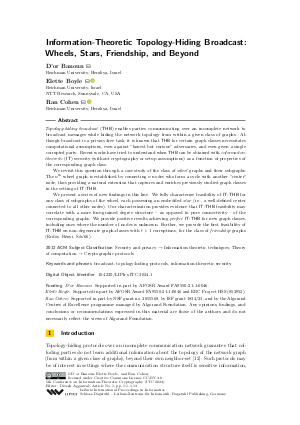Information-Theoretic Topology-Hiding Broadcast: Wheels, Stars, Friendship, and Beyond
Authors
D'or Banoun,
Elette Boyle  ,
Ran Cohen
,
Ran Cohen 
-
Part of:
Volume:
5th Conference on Information-Theoretic Cryptography (ITC 2024)
Part of: Series: Leibniz International Proceedings in Informatics (LIPIcs)
Part of: Conference: Conference on Information-Theoretic Cryptography (ITC) - License:
 Creative Commons Attribution 4.0 International license
Creative Commons Attribution 4.0 International license
- Publication Date: 2024-08-06
File

PDF
LIPIcs.ITC.2024.1.pdf
- Filesize: 0.67 MB
- 13 pages
Document Identifiers
Subject Classification
ACM Subject Classification
- Security and privacy → Information-theoretic techniques
- Theory of computation → Cryptographic protocols
Keywords
- broadcast
- topology-hiding protocols
- information-theoretic security
Metrics
- Access Statistics
-
Total Accesses (updated on a weekly basis)
0PDF Downloads0Metadata Views
Abstract
Topology-hiding broadcast (THB) enables parties communicating over an incomplete network to broadcast messages while hiding the network topology from within a given class of graphs. Although broadcast is a privacy-free task, it is known that THB for certain graph classes necessitates computational assumptions, even against "honest but curious" adversaries, and even given a single corrupted party. Recent works have tried to understand when THB can be obtained with information-theoretic (IT) security (without cryptography or setup assumptions) as a function of properties of the corresponding graph class. We revisit this question through a case study of the class of wheel graphs and their subgraphs. The nth wheel graph is established by connecting n nodes who form a cycle with another "center" node, thus providing a natural extension that captures and enriches previously studied graph classes in the setting of IT-THB. We present a series of new findings in this line. We fully characterize feasibility of IT-THB for any class of subgraphs of the wheel, each possessing an embedded star (i.e., a well-defined center connected to all other nodes). Our characterization provides evidence that IT-THB feasibility may correlate with a more fine-grained degree structure - as opposed to pure connectivity - of the corresponding graphs. We provide positive results achieving perfect IT-THB for new graph classes, including ones where the number of nodes is unknown. Further, we provide the first feasibility of IT-THB on non-degenerate graph-classes with t > 1 corruptions, for the class of friendship graphs (Erdös, Rényi, Sós '66).
Cite As Get BibTex
D'or Banoun, Elette Boyle, and Ran Cohen. Information-Theoretic Topology-Hiding Broadcast: Wheels, Stars, Friendship, and Beyond. In 5th Conference on Information-Theoretic Cryptography (ITC 2024). Leibniz International Proceedings in Informatics (LIPIcs), Volume 304, pp. 1:1-1:13, Schloss Dagstuhl – Leibniz-Zentrum für Informatik (2024)
https://doi.org/10.4230/LIPIcs.ITC.2024.1
BibTex
@InProceedings{banoun_et_al:LIPIcs.ITC.2024.1,
author = {Banoun, D'or and Boyle, Elette and Cohen, Ran},
title = {{Information-Theoretic Topology-Hiding Broadcast: Wheels, Stars, Friendship, and Beyond}},
booktitle = {5th Conference on Information-Theoretic Cryptography (ITC 2024)},
pages = {1:1--1:13},
series = {Leibniz International Proceedings in Informatics (LIPIcs)},
ISBN = {978-3-95977-333-1},
ISSN = {1868-8969},
year = {2024},
volume = {304},
editor = {Aggarwal, Divesh},
publisher = {Schloss Dagstuhl -- Leibniz-Zentrum f{\"u}r Informatik},
address = {Dagstuhl, Germany},
URL = {https://drops.dagstuhl.de/entities/document/10.4230/LIPIcs.ITC.2024.1},
URN = {urn:nbn:de:0030-drops-205090},
doi = {10.4230/LIPIcs.ITC.2024.1},
annote = {Keywords: broadcast, topology-hiding protocols, information-theoretic security}
}
Author Details
Funding
- Banoun, D'or: Supported in part by AFOSR Award FA9550-21-1-0046.
- Boyle, Elette: Supported in part by AFOSR Award FA9550-21-1-0046 and ERC Project HSS (852952).
- Cohen, Ran: Supported in part by NSF grant no. 2055568, by ISF grant 1834/23, and by the Algorand Centres of Excellence programme managed by Algorand Foundation. Any opinions, findings, and conclusions or recommendations expressed in this material are those of the authors and do not necessarily reflect the views of Algorand Foundation.
References
-
Adi Akavia, Rio LaVigne, and Tal Moran. Topology-hiding computation on all graphs. In 37th Annual International Cryptology Conference (CRYPTO), part I, pages 447-467, 2017.

-
Adi Akavia and Tal Moran. Topology-hiding computation beyond logarithmic diameter. In 36th Annual International Conference on the Theory and Applications of Cryptographic Techniques (EUROCRYPT), part III, pages 609-637, 2017.

-
Marshall Ball, Alexander Bienstock, Lisa Kohl, and Pierre Meyer. Towards topology-hiding computation from oblivious transfer. In Proceedings of the 21st Theory of Cryptography Conference (TCC), part I, pages 349-379, 2023.

-
Marshall Ball, Elette Boyle, Ran Cohen, Lisa Kohl, Tal Malkin, Pierre Meyer, and Tal Moran. Topology-hiding communication from minimal assumptions. In Proceedings of the 18th Theory of Cryptography Conference (TCC), part II, pages 473-501, 2020.

-
Marshall Ball, Elette Boyle, Ran Cohen, Tal Malkin, and Tal Moran. Is information-theoretic topology-hiding computation possible? In Proceedings of the 17th Theory of Cryptography Conference (TCC), part I, pages 502-530, 2019.

-
Marshall Ball, Elette Boyle, Tal Malkin, and Tal Moran. Exploring the boundaries of topology-hiding computation. In 37th Annual International Conference on the Theory and Applications of Cryptographic Techniques (EUROCRYPT), part III, pages 294-325, 2018.

-
Paul Erdös, Alfréd Rényi, and Vera T. Sós. On a problem of graph theory. Studia Sci. Math. Hungar., 1:215-235, 1966.

-
Martin Hirt, Ueli Maurer, Daniel Tschudi, and Vassilis Zikas. Network-hiding communication and applications to multi-party protocols. In 36th Annual International Cryptology Conference (CRYPTO), part II, pages 335-365, 2016.

-
Rio LaVigne, Chen-Da Liu Zhang, Ueli Maurer, Tal Moran, Marta Mularczyk, and Daniel Tschudi. Topology-hiding computation beyond semi-honest adversaries. In Proceedings of the 16th Theory of Cryptography Conference (TCC), part II, pages 3-35, 2018.

-
Rio LaVigne, Chen-Da Liu Zhang, Ueli Maurer, Tal Moran, Marta Mularczyk, and Daniel Tschudi. Topology-hiding computation for networks with unknown delays. In Proceedings of the 23rd International Conference on the Theory and Practice of Public-Key Cryptography (PKC), part II, pages 215-245, 2020.

-
Shuaishuai Li. Towards practical topology-hiding computation. In Shweta Agrawal and Dongdai Lin, editors, 28th International Conference on the Theory and Application of Cryptology and Information Security (ASIACRYPT), part I, pages 588-617, 2022.

-
Tal Moran, Ilan Orlov, and Silas Richelson. Topology-hiding computation. In Proceedings of the 12th Theory of Cryptography Conference (TCC), part I, pages 159-181, 2015.

